Why a holiday in Albania? Isn’t it far too dangerous? We’ve often heard these and many other questions. To be honest, we ourselves don’t really know why we wanted to travel to this country in particular. It was probably the unknown and the uncertain that sparked our sense of adventure. The name flashed across our screens here and there and seemed to stick in our minds.
At some point, the decision was made and the flights were booked. We didn’t know much about the country, and that’s exactly what made this trip so exciting. In the following article, we’ll take you along and tell you everything you need to know for your vacation in Albania. We also give you some useful tips that might help you with your travel planning.
These articles might interest you
- These articles might be of interest to you
- General information
- Arriving by plane
- Arriving by ship
- Arriving by car
- Best time to travel to Albania
- Safety in Albania
- Booking accommodation
- Camping in Albania
- Booking a rental car
- Driving in Albania
- Albania vacation – costs
- Highlights in Albania
- Food in Albania
- Albania’s past & the dictatorship
- The huge garbage problem
- Conclusion: Albania
- Our Albania Podcast
General Information
Albania is located in southeastern Europe and borders Montenegro, Greece, Kosovo, and North Macedonia. Around 2.9 million people live there today, while around 4 million Albanians live abroad. Many emigrated because they saw no prospects in their homeland.
Unemployment and poverty were – and in some cases still are – reasons for emigration. Although the situation has improved somewhat since the end of communism, Albania remains one of the poorest countries in Europe.
With an area slightly smaller than Belgium, the country boasts stunning natural beauty: high mountain ranges, rolling hills, white sandy beaches, beautiful bays, and charming villages. There are 14 national parks in total, perfect for outdoor activities. Whether hiking, a city trip, or a beach holiday – Albania has an incredible amount to offer.
To ensure you have enough time to discover it all, you should plan at least a week – or better yet, two. And the best part: Albania is one of the cheapest travel destinations in Europe. Our entire trip cost just €290 per person. Pretty impressive, right?
Arriving by plane
You have several options for traveling to Albania. There is only one airport in the country itself, and it is located in the capital, Tirana. Flights from Germany are not that expensive. From Memmingen and Dortmund, you can fly with Wizzair for under €100 round-trip (without luggage), and from Düsseldorf, Blu-Express (operated by Albawings) flies to Tirana.
You can get a round-trip flight for as little as €120, but it also depends on the time of year. Lufthansa flies to Tirana year-round from Munich, and Adria Airways also flies from Frankfurt during the summer months. Other airlines include Austrian, Alitalia, Olympic, and others, but these first make a stopover with a transfer in their home country.
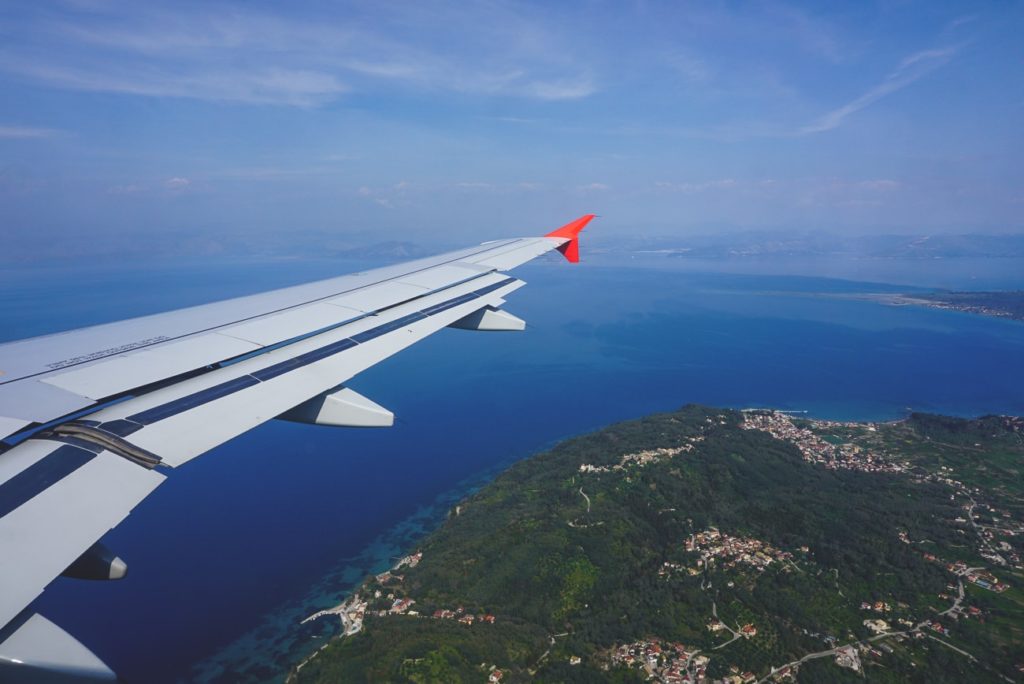
Another option is to fly to Corfu (Greece) and then take the ferry* (that’s what we did). This way, you’ll save a few euros and also get to see the beautiful Greek island of Corfu. For us, it was the perfect combination and also a somewhat more exciting adventure. Flights to Corfu depart from Frankfurt, Berlin, Cologne, Düsseldorf, Leipzig, Hamburg, and Dresden. Depending on the airline, flights aren’t expensive at all.
Arriving by Ship
Many vacationers arrive in Albania by ship, which is why we did a little research on this point. You can take the ferry from Corfu to Albania (Saranda) every day. A one-way trip costs €18 per person. You can buy tickets on site or book them online in advance. We booked with Finikas Lines. You can also get tickets from Ionian Seaways or Directferries.com*.
In Corfu, there are many offices near the port where you can easily buy your tickets. On the other side, in Saranda, Albania, you’ll find the terminal right at the port, where you can also purchase your tickets. But be careful: During the winter months, the ferry only runs twice a day. There are ferries operated by Flying Dolphin and Saranda Express.

From Italy, for example, you can travel from Bari to Durres. The ferry (Adria Ferries) departs every evening at 11 p.m. and arrives at the port of Durres around 7 a.m. the next morning. You can also travel from Ancona or Trieste to Durres, but unfortunately not every day. You can also travel from Brindisi to Vlorë or Saranda. Long-haul flights are available with Anek Lines and Minoan Lines from Venice and Trieste to Igoumenitsa or Corfu.
Arriving by car
Some people also dare to travel the long way to Albania in their own car (or camper, bus, or caravan). However, you should plan at least three days for this. You can travel to Albania via Italy by ferry, or without a ferry through the various Balkan countries. You could travel via Croatia and Montenegro, or via Belgrade and New Macedonia. Another option is to travel via Belgrade and Kosovo.
At the border with Kosovo, you must purchase additional car insurance, which costs around €40. You may also encounter problems on the return journey at the Kosovo-Serbian border if you are traveling from Albania. The border crossings to Albania are said to be very accurate and modern. Attention: Don’t forget your green insurance card!
Best time to travel to Albania
Anyone who thinks that Albania already has summery warm temperatures in April is mistaken. We also thought that the country would be a bit warmer by then. We had sunny, mild days, but also cold, rainy ones. We wouldn’t choose April as a travel month again.
The high season starts in July and lasts until August. Most tourists arrive then from neighboring countries. According to online climate tables, the best time to travel is in the months of May, June, early July, September, and October. The mountains (Albanian Alps) have a typical mountain climate with very cold and snowy winters.
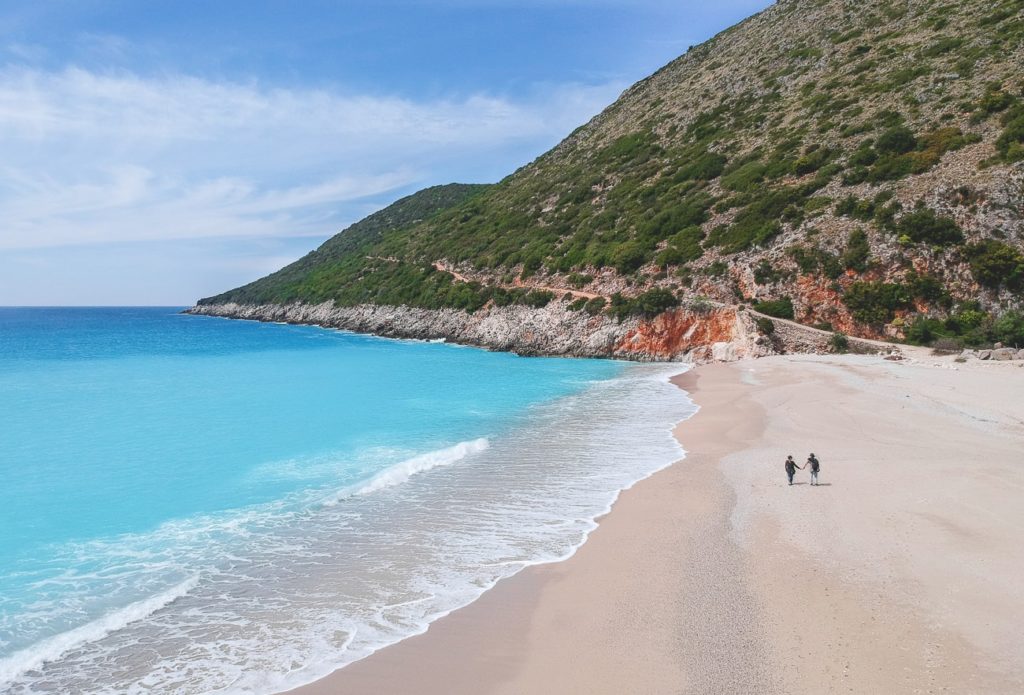
The further south you travel, the more Mediterranean the climate becomes. Most of the rain falls in the winter months between November and April. But you can never predict it exactly. The locals, for example, were very surprised by the amount of rain in April. And even in October, you can have wonderful weather in Albania. The good thing about the off-season is, of course, that you have many spots all to yourself. In addition, accommodation prices are even lower.
Safety in Albania
Many readers have asked us about the safety situation in Albania. We can tell you that Albania is a very safe country to travel to. This country’s reputation is far worse than reality actually reveals. Albanians are warm, open, and incredibly hospitable.
We never felt unsafe or uncomfortable in the country. Of course, there are some bad apples in Albania, just like in any other country. However, violence in petty and street crimes is rare, for example.
Of course, you should still use common sense when traveling through the country. Keep valuables and identification documents safe and not carry them openly. Never leave anything in your car (or hide it well). It’s also said that there has been an increase in car and caravan break-ins. You should be especially careful here. It can be dangerous on the roads, for example, because animals often stray across them. More on that in the “Driving in Albania” section.
Booking Accommodation
Since we were in the country during the off-season, we were able to book our accommodations spontaneously a day in advance or early in the morning. On average, we paid around €20, including breakfast, for both of us. During this time, you can also find 4-star hotels for €30 or €40. Albania is a very affordable country, and you really get a lot for your euro. However, the standard here is somewhat different than in Germany.
The rooms are usually very old-fashioned and simply furnished. But it just has to function, not look super fancy, right? We didn’t have any bad experiences with our accommodations. There was always a bed, a shower, storage space, and sometimes a bit more comfort, even if we paid more.
Note: In April, however, it was very cold in many accommodations. The air conditioning and cold floor tiles are more suited to summer. Usually, there was only a thin sheet for blankets. So we always had to ask for thicker ones. At night, it almost always cooled down to a few degrees Celsius. If you’re traveling in April, you should generally pack long clothes, such as a jacket, thick socks, and sweaters. We didn’t even need our summer clothes.
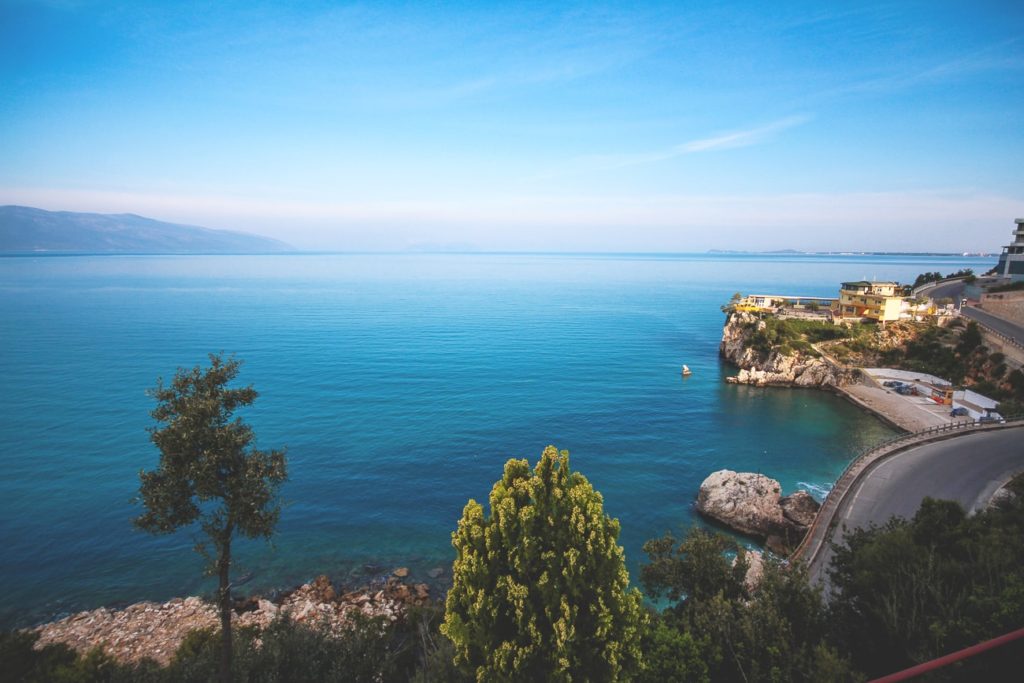
We always booked through Booking.com* or, if possible, directly through the website of the respective accommodation. If you’ve found your accommodation on Booking.com, it’s best to book it directly. This way, the owners don’t have to pay Booking.com fees.
People in Albania already have very little money. This way, you can support them a little bit. However, there are also many accommodations in Albania that can only be found on Booking.com because they can’t afford a website (or don’t know how it all works).
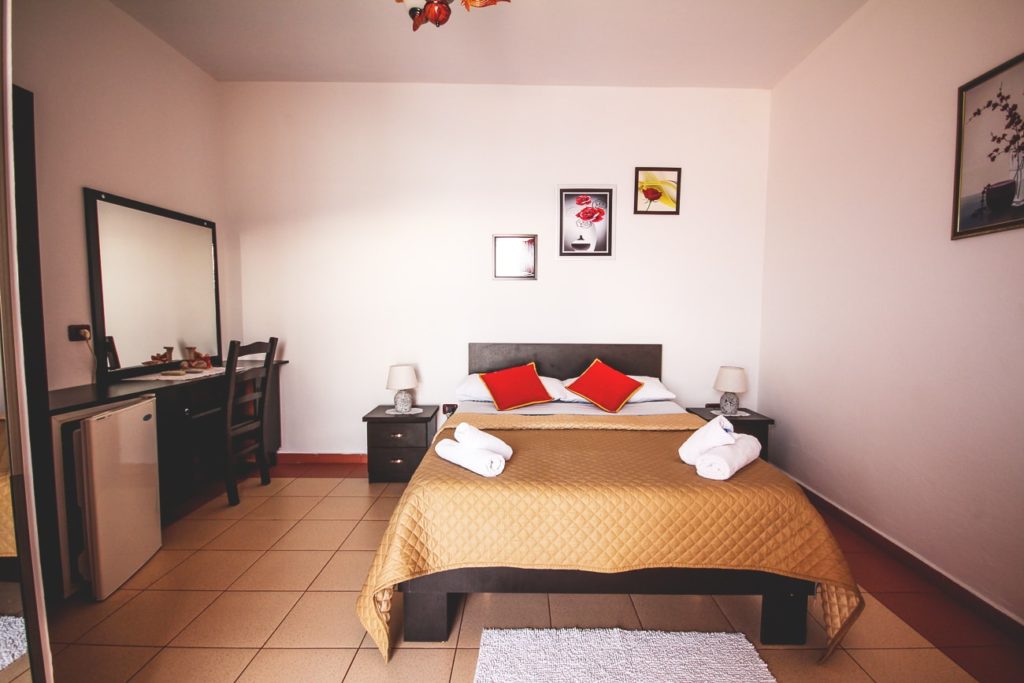
In most places, you can get a good and clean room for €15 to €20 per night for two people. A simple breakfast is usually included (toast, egg, jam, butter, coffee, tea). In high season, prices are usually higher, but still cheap when compared to other countries.
Our accommodations in Albania
Prices for 2 people
- Arrival Corfu: Airbnb in the city center (45€ per night)
- Ksamil: Villa Nertili (15€ including breakfast)
- Vlorë: Blue Dream Hotel (20€ including breakfast)
- Tirana: Guest House Mary (22€ including breakfast)
- Tirana: Hotel Stela Center (40€ including breakfast)
- Saranda: Sunset Apartments (12€ without breakfast)
- Departure Corfu: Mayor Mon Repos Palace (30€ with breakfast)
Camping in Albania
We have indeed received many messages about The topic was “Camping in Albania.” Although we didn’t camp in the country ourselves, we did some research. Camping is certainly possible in Albania. Even so-called “wild camping” is still permitted; it’s simply part of a “real adventure.” Cool, right?
There aren’t an infinite number of campsites in the country, but they are at regular intervals. These are said to be quite well-equipped. You can find an overview here: Campsites in Albania. If you’re coming into the country with your camper, you must be able to present your green insurance card, as well as your ID and vehicle registration documents.
Book a rental car
If you want to take a road trip through Albania, you should rent a suitable car. We booked a small car online in Saranda in advance (we got a larger Opel Astra). We paid €150 for a week, including all important insurance and services. If you rent your car in Tirana, it might be cheaper because you simply have more choice there.
However, at billiger-mietwagen.de* we get the best deal up front with the all-inclusive package. This way, we don’t have to book any extra services on-site. When booking, make sure you select “no excess,” unlimited mileage, glass and tire coverage, and a fair fuel policy (full/full). Also pay close attention to the amount of liability insurance stated.
Driving in Albania
Driving is free in Albania; there are currently no tolls. We initially thought that the road conditions in the country would be much worse. When we actually arrived, it wasn’t that bad at all; in fact, they were actually quite good. Most roads are paved and in solid to very good condition. Only rarely did we have to drive on gravel roads. The roads along the coast up to Tirana were all very well maintained.
We were also able to drive the roads inland towards Gjirokastra without any problems. The only thing that really annoyed us were the speed limits. Often we were only allowed to drive 40 km/h, sometimes 60. This meant we didn’t make as much progress as we had planned. Unfortunately, we had to cancel our detour to the Albanian Alps due to time constraints. It’s a shame, but we’ll make up for it.
The roads in the mountains are said to be not so good. Be prepared for longer car journeys here (Koman, Valbona, Theth, and the like). There are a few “highways” where you can even drive 90 km/h or 110 km/h. These are marked blue or green. You’ll also have to slow down when crossing mountain passes.
You can easily plan on 3 to 3.5 hours for 150 kilometers along the coast. The traffic in Tirana is a bit more chaotic. You should have some practice here and not let it get you down. Albanians often drive very selfishly and suddenly squeeze into the smallest gap. In general, driving in Albania is unproblematic and quite safe.
You are allowed to drive a maximum of 40 km/h in urban areas, 80 km/h in rural areas, 90 km/h on expressways (blue), and 110 km/h on motorways (green). Very few Albanians adhere to these limits, but you should still adhere to them. Police checkpoints are common outside of urban areas. At gas stations, simply tell the attendant how much you need to fill up, and they will take care of everything for you.
All you have to do is pay at the windshield and you can continue on your way. Gas stations are almost always close together, unless you are far away from any civilization. And be careful: Goats, cows, donkeys, horses, and dogs often wander around the streets. So drive with foresight.

Albania Vacation – Costs
A trip to Albania is really very affordable. Whether it’s food, accommodation, or sightseeing – you really get a lot for your euro in Albania. Currently, you get around 100 Albanian lek for 1 €. We spent an average of €15 to €20 on accommodation during the low season (usually including breakfast). The car cost us around €20 per day, and restaurant visits often cost no more than €12 to €15 for two people, including drinks, starter, and main course.
You can also shop cheaply at the supermarket; the prices are comparable to ours. However, it’s much more worthwhile to eat out rather than cook yourself. The most “expensive” items were actually the car and the gas. Of a total of €572, we paid €218 for that alone. The remaining €354 was spent on food, drinks, sightseeing, shopping, and accommodation. On average, we spent €40 per person per day (for everything).
Highlights in Albania
Seaside resort of Ksamil
Several sights and highlights await you in Albania, as the country is truly very diverse. First, there’s the beautiful coast in the south, the many national parks, the Albanian Alps in the far north, the capital Tirana, and many other cities steeped in history and tradition. In the south lies the seaside resort of Ksamil, a true highlight of Albania during the off-season.
During the high season, it’s said to be like a party at Ballermann. We had the beaches and islands all to ourselves. The colors of the water…simply stunning, isn’t it? We also had a very good meal on the beach at the Abiori Restaurant. Our best tips and highlights in Ksamil here.

Butrint National Park
Continue on to Butrint National Park, where you can see a truly beautiful ancient port city dating back to the 8th century BC. The park is surrounded by Lake Butrint and the Vivar Canal and is home to 800 plant species, more than 240 bird species, 15 fish species, and 39 mammal species.
The ruins of Butrint are an important building block of the past. The protected location in a lagoon was already attractive to conquerors, travelers, and those seeking relaxation. Butrint is actually something like a second Troy, only on a smaller scale. We really enjoyed the tour. The entrance fee is 1000 LEK per person (approx. €10).

The Blue Eye – Syri i Kaltër
On the way to Gjirokastra, you pass the famous Blue Eye. This almost 50-meter-deep hole in a river magically attracts many visitors. And we didn’t want to miss it either. While there isn’t much to do there, the scenery is almost magical (even if there is a lot of trash lying around). Everything glows in green, blue, and purple, a beautiful sight. We hope that the large amount of trash will be cleared away soon. This is the only way to protect this beautiful little paradise.
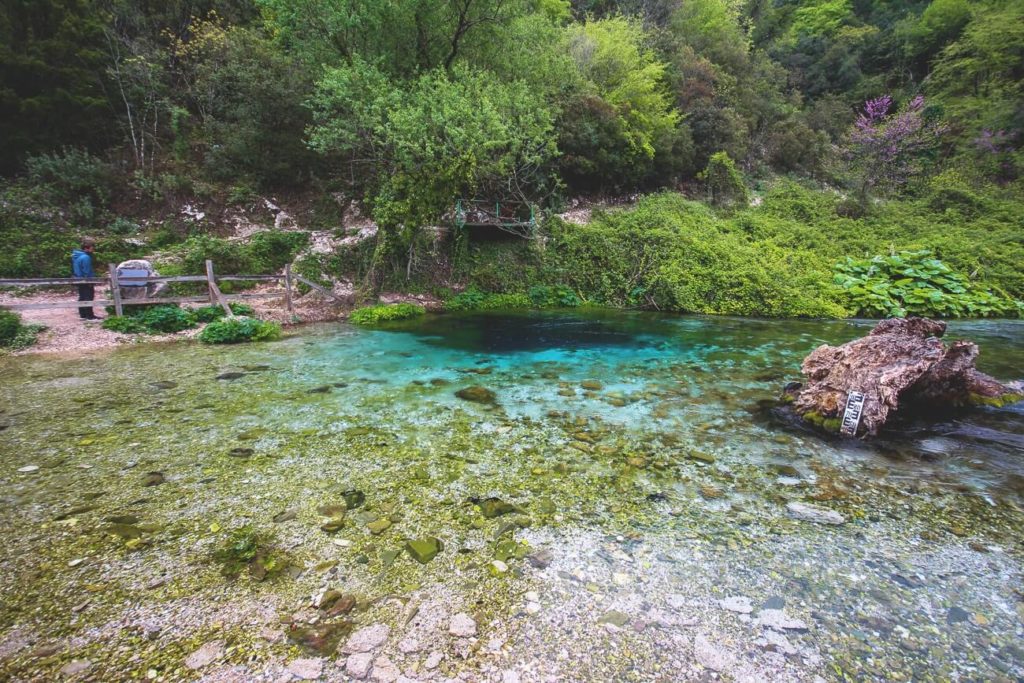
The historic town of Gjirokastra
Of course, a detour to Gjirokastra is a must. This historic town is located in the south of the country and has a population of around 20,000. In 2005, the town was declared a UNESCO World Heritage Site. The surrounding mountains (Mali i Gjerë) rise to almost 2,000 meters.
The wide valley of the Drino River seems almost surreal, as if from a bygone era. The stone houses here climb several hundred meters up the mountain. The old town is home to many small restaurants and shops, and at the top of the hill is the castle of Gjirokastra. More about this here: Our best tips for Gjirokastra.
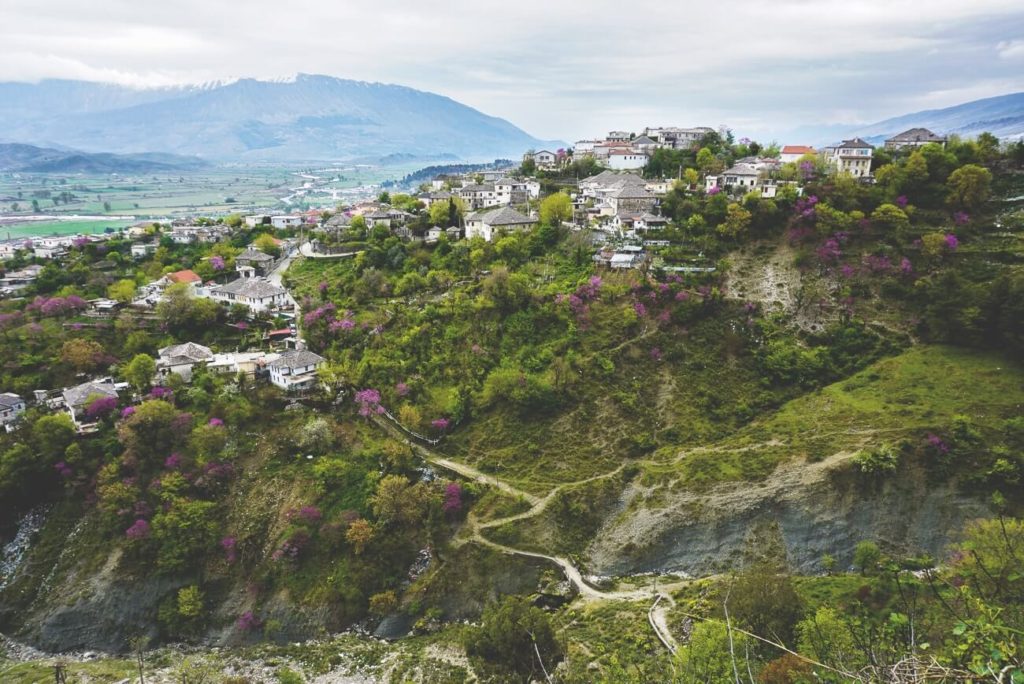
Albanian Riviera
The Albanian Riviera is still one of the most unspoiled corners of the country. It stretches from the Llogara Pass to Saranda. Here, the Ceraunian Mountains separate the Riviera from the hilly hinterland. Many parts of the Albanian Riviera are almost inaccessible. You drive through many mountain villages that look down on the strangely empty sea from a safe distance.
If a road does lead down to the sea (as in Dhërmi, for example), apartment buildings, restaurants, and hotels are loosely lined up next to each other. New concrete is replacing old stone walls. The tourist center of the Riviera is Himara. Popular beaches: Drymades Beach, Gjipe Beach, Livadhi Beach, Porto Palermo Beach, and Qeparo. And don’t miss the bakery just beyond the Llogara Pass – Pastiçeri Barba Niko. There you can find delicious coffee and freshly baked goods from the oven.
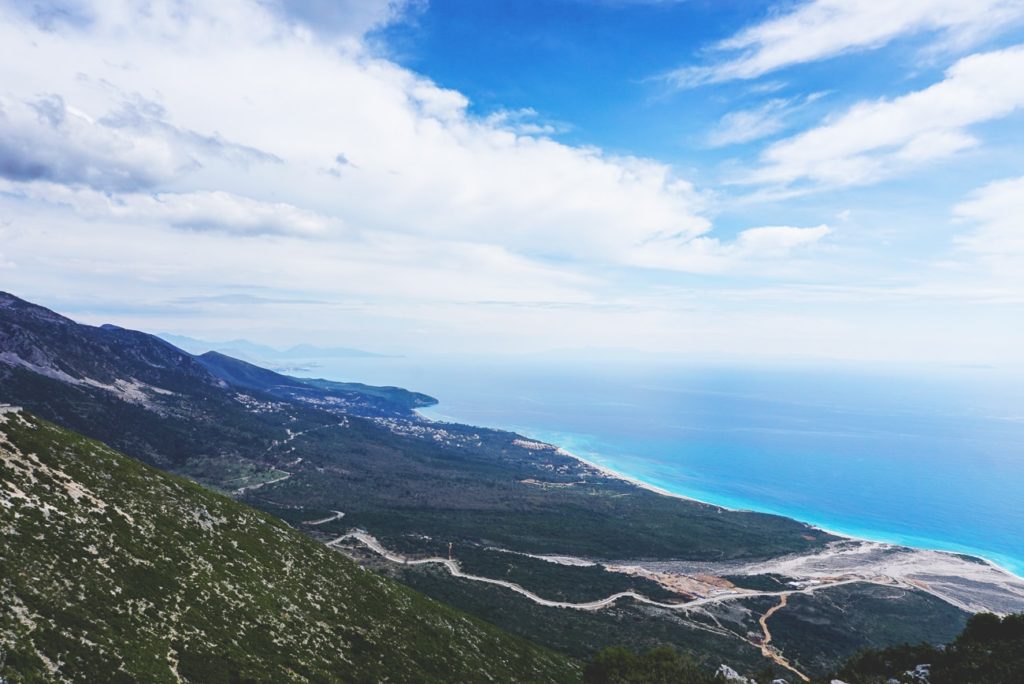
Gjipe Beach & Canyon
We discovered Gjipe Beach on Google Maps and simply drove there. The access to the parking lot is quite easy. It’s best to park your car right there. After that, you should walk the 30 minutes, as this gravel road is not for the faint of heart or cars. We wouldn’t have even gone there in an off-road vehicle. But the walk is worth it, as you pass several bunkers along the way.
After the last bend, a wonderful view of the bay and the canyon behind it opens up. The colors were truly unique; the water shone in the most beautiful shades of blue. There was no one else on the beach except us, just two campers in the gorge. Of course, it looks completely different in summer. Then there are umbrellas, loungers, and the small snack stands open.
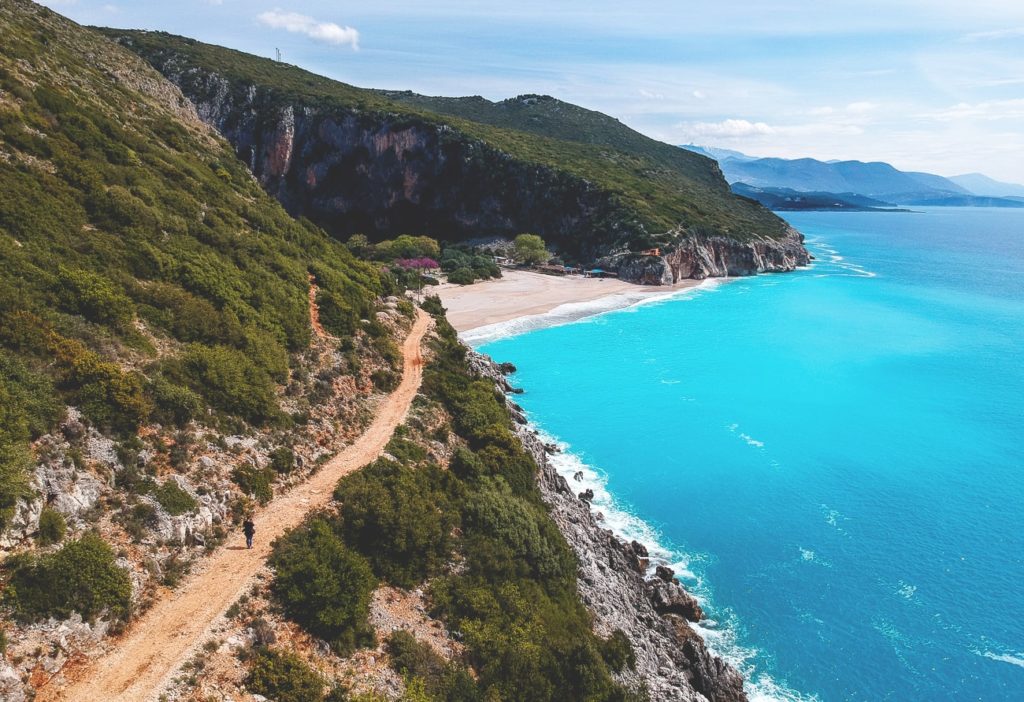
Llogara National Park & Pass
On the way from Seranda to Vlorë, you inevitably have to cross the beautiful Llogara Pass and then find yourself in Llogara National Park. This pass is a mountain pass and part of the SH 8 national road. The pass separates the Albanian Riviera from the hinterland. The route is truly beautiful.
In good weather, you can see beautiful bays and beaches from a distance, as well as the highest peak of the Ceraunian Mountains (Maja e Cikës). In the national park itself, you can go hiking, book accommodation, and dine in restaurants. The southern slope of the pass is also a launching point for paragliders.

The City of a Thousand Windows – Berat
About 100 kilometers south of Tirana lies the city of Berat. Together with Gjirokastra, the two cities are among the most popular and beautiful in the entire country. In 2008, the old town of Berat was declared a UNESCO World Heritage Site. The city consists of a new town and three protected districts. High above sits the fortress (Kalaia) with its many winding streets, small churches, and mosques.
The small district is quiet, and the views from there are stunning. The city of Berat is nicknamed the “City of a Thousand Windows.” You’ll see why when you explore the Mangalem district. The houses are close together, and all have large windows. Hence the city’s nickname.

The Osum Canyon
The Osum Canyon is often called the Grand Canyon of Albania—and not without reason. The gorge stretches for approximately 13 kilometers, is between 2 and 30 meters wide, and in some places even up to 80 meters deep. Those up for a longer hike can walk around the canyon in about 6 hours.
Impressive views await you along the way. The trail begins at the narrow suspension bridge over the Osum River, right at the edge of Corovoda. From there, narrow paths lead along the gorge, past waterfalls, caves, and even broken stalactites. But be careful: you won’t find any railings here – so it’s best to proceed with caution!
Shkodra in the North
The city of Shkodra lies in northern Albania between Lake Skadar and the Buna, Drin, and Kir rivers. It is just 34 kilometers from the border with Montenegro. The city, which is 2,400 years old, has a population of almost 143,000. Shkodra is also the cultural and traditional center of northern Albania.
Here you will find mosques, churches, castles, and palaces from times long past. Lake Shkodra is the largest lake in the Balkans and belongs to two-thirds of Montenegro. Many tourists use Shkodra as a starting point for tours to the Albanian Alps and Lake Koman.
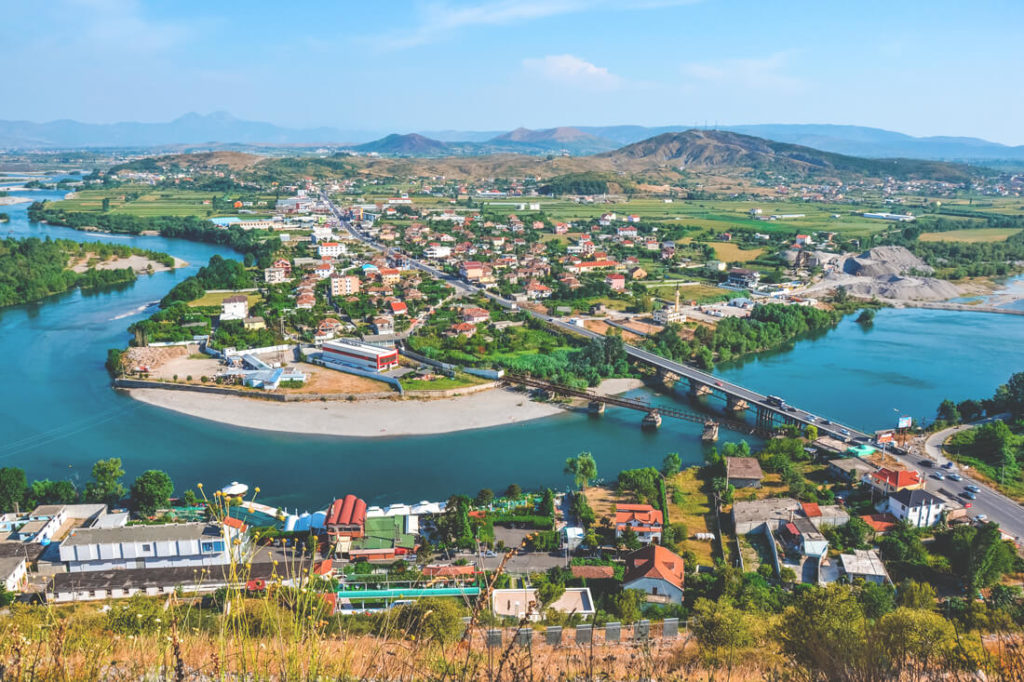
Lake Koman and Ferry
The Koman Reservoir is just under two hours from Shkodra. You can only cross this lake by ferry. The journey is the destination, as the scenery is simply stunning. To the left and right, the steep rock faces, behind them the mighty mountain ranges of the Albanian Alps, and in front of you, the blue waters of the reservoir in the Drini Gorge.
The water has been dammed here since the 1980s to supply the north of the country with energy. The lake is 34 kilometers long, just 50 meters wide at its narrowest point. The deepest point is just under 96 meters.
Two car ferries travel daily between Koman and Fierza. The trip takes around 2.5 hours and leads past high cliffs and through narrow gorges. They are somewhat reminiscent of Norwegian fjords. During the winter months, only the ferry from Fierza to Koman and back runs. From mid-April, the ferry also departs from Koman to Fierza and back.
This would make for a great day trip by ferry. You can buy your ticket here. The round trip costs only around €18 per person. We were unlucky with the weather, so we had to skip the planned tour to Lake Koman and the mountains for the time being.

The Albanian Alps
The Albanian Alps are among the absolute highlights of the country. At the very top of the north of the country, you’ll find a unique and spectacular landscape with peaks rising more than 2,600 meters into the sky. Valleys, mountain lakes, and breathtaking viewpoints await you there.
The hike from the Valbona Valley to the Theth Valley (15 kilometers | 6 to 8 hours) is particularly popular. Here, some of the roads are still very bumpy and not as well-developed as in other parts of the country. The highest mountain in the Albanian Alps is Jezerca at 2,692 meters. You can also find guesthouses and pensions in the towns of Valbona and Theth.
The long-distance hiking trail “Peaks of the Balkans” is also very popular with hikers. It is 192 kilometers long and runs over 10 daily stages through Albania, Kosovo, and Montenegro. This trail is not necessarily for beginners. The trail leads through developed areas as well as through remote high-alpine regions. Awesome, we definitely want to do it sometime.
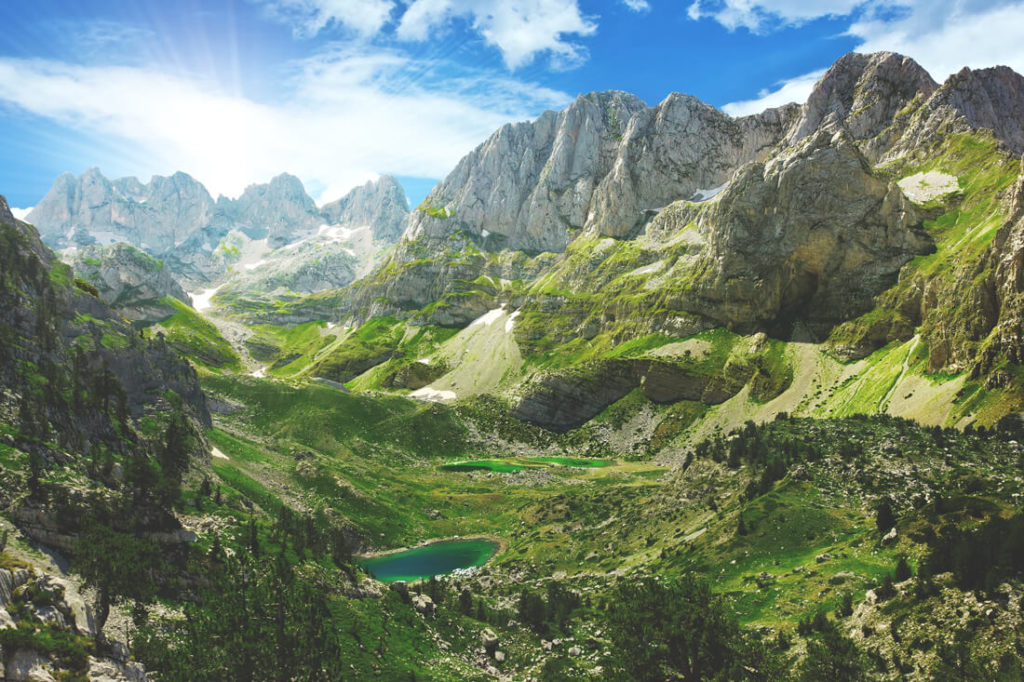
Capital Tirana
A detour to the capital Tirana is also worthwhile. After almost a week traveling across the country, we found a bit of urban city life again in Tirana. You can find just about everything here: shopping malls, restaurants, cafés, shops, hotels, and so on. We were impressed by the city’s relaxed vibe, strolled through the streets and parks, drank some damn good coffee, ate delicious chocolate cake, and stayed overnight in a chic, new hotel.
If you want to learn more about the socialist past, be sure to visit BunkArt 1 or BunkArt 2. You can also drive from Tirana to the Bovilla Reservoir. This is a reservoir that provides the capital’s drinking water. There’s a small path up the mountain from where you have a great view. We have written a detailed article about this city: Albania’s Capital Tirana – Tips & Highlights.
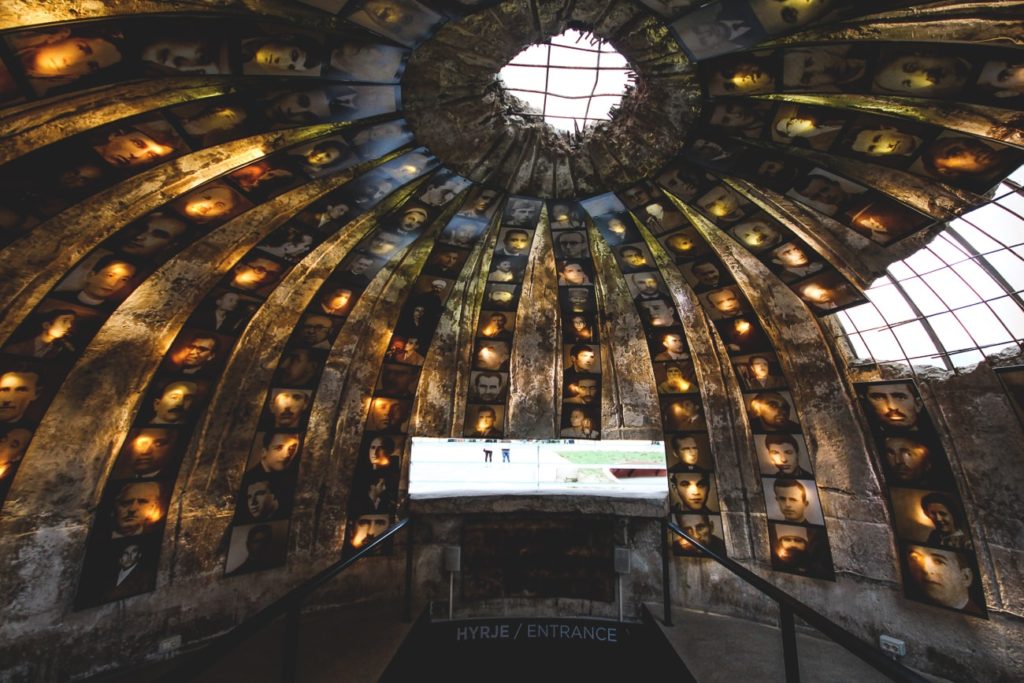
Bunkers in the Country
There are probably 170,000 to 200,000 bunkers in the country. These were built between 1972 and 1984. The reason: Enver Hoxha wanted to protect the country from foreign troops. These bunkers were the most important military installations in the country and were built during the communist regime. They can still be seen everywhere today. There were three different types of bunkers. The dictator’s goal was to create space for four Albanians per bunker.

In total, 750,000 bunkers would have had to be built. To this day, no one knows exactly how many there actually were. According to one report, only 173,371 bunkers were built by the end of the main construction phase. Locals aren’t so happy about this, as the bunkers are testaments to the dictatorship. You’re sure to see one or two during your trip. In Tirana, there are two large bunkers that have been converted into museums (BunkArt 1 & BunkArt 2).
Other Highlights
There are so many other places in the country worth visiting. For example, the town and fortress of Kruja, north of Tirana. Cape Rodon, southwest of Tirana, is a 10-kilometer-long headland that juts out into the sea. A truly beautiful photo opportunity. In the southeast of the country lies the city of Korça. With 51,000 inhabitants, it is one of the largest and is considered the birthplace of Albanian literature and is often referred to as the “cradle of Albanian culture.” Many people also travel from Albania to the surrounding countries, such as Montenegro, New Macedonia, and Greece. These can be wonderfully combined on a road trip. Can you recommend any other highlights? Feel free to write it in the comments.
Food in Albania
The food in Albania is a colorful mix of different influences – no wonder, since the country is located right next to Turkey, Greece, and Italy. The cuisine is Mediterranean in character and similar to that of neighboring countries such as Kosovo, North Macedonia, Serbia, and Montenegro. Fresh vegetables, chicken, lamb, beef, goat, and fish are the main dishes on the table.
You’ll find pizzerias and taverns on every corner. While pizza awaits you in the pizzeria, of course, taverns serve typical Albanian dishes. But don’t worry if you’re in the mood for something different – burgers, fries, soups, salads, and wraps are also on many menus.
One of the classics of Albanian cuisine is the bean soup “Fasul,” which is made with meat and vegetables. It is often served with buttermilk, tea, wine, or raki. Another highlight is “Dollma” – vine leaves stuffed with rice and meat.
You should also definitely try “Byrek,” crispy pastries with minced meat, feta cheese, or spinach. Flatbread or various cheeses are available as a side dish. And for dessert? Baklava! You can get this sweet puff pastry with syrup almost everywhere – an absolute must.
Albania’s Past & the Dictatorship
To understand why Albania is the way it is, it’s worth taking a look into the past. In 1944, the communists under Enver Hoxha seized power. He founded the secret police, Sigurimi, which claimed tens of thousands of victims over the next 40 years. The country was poor, the economy was in ruins, and infrastructure lacked. Lack of education, epidemics, and blood feuds dominated everyday life.
Hoxha’s rule was characterized by state violence and massive human rights violations. Criticism of the party was punished with imprisonment, forced relocation, or even execution. Travel abroad was forbidden, and in 1967, Hoxha declared Albania the world’s first atheist state—churches and mosques were closed or destroyed.
After the Second World War, Albania experienced what was arguably the strictest communist dictatorship in Europe. Hoxha completely isolated the country and had 750,000 bunkers planned to prepare for possible attacks. However, only about 200,000 bunkers were built by his death in 1985.
His successor continued the policy until 1990. The first democratic elections were not held until 1992, and the country opened up to the world. Today, Albania is a NATO member and an official EU candidate since 2014.
The Huge Garbage Problem
When you travel through Albania, one thing will immediately strike you: There’s garbage everywhere. Really everywhere. There are several reasons for this, as we discovered. The country lacks money and waste disposal facilities. As a result, residents are practically forced to simply throw their garbage into the wild. Where else would they put it?
With the country’s opening in 1992, a flood of garbage arose that Albania was unable to cope with. The consumer society, the flood of plastic, and a lack of proper disposal made life difficult for the population. There were and are mountains of garbage and illegal dumping sites everywhere. You’ll also see garbage in rivers, ditches, on the streets, and in fields. Even sheep, cows, horses, chickens, cats, and dogs search for food there.
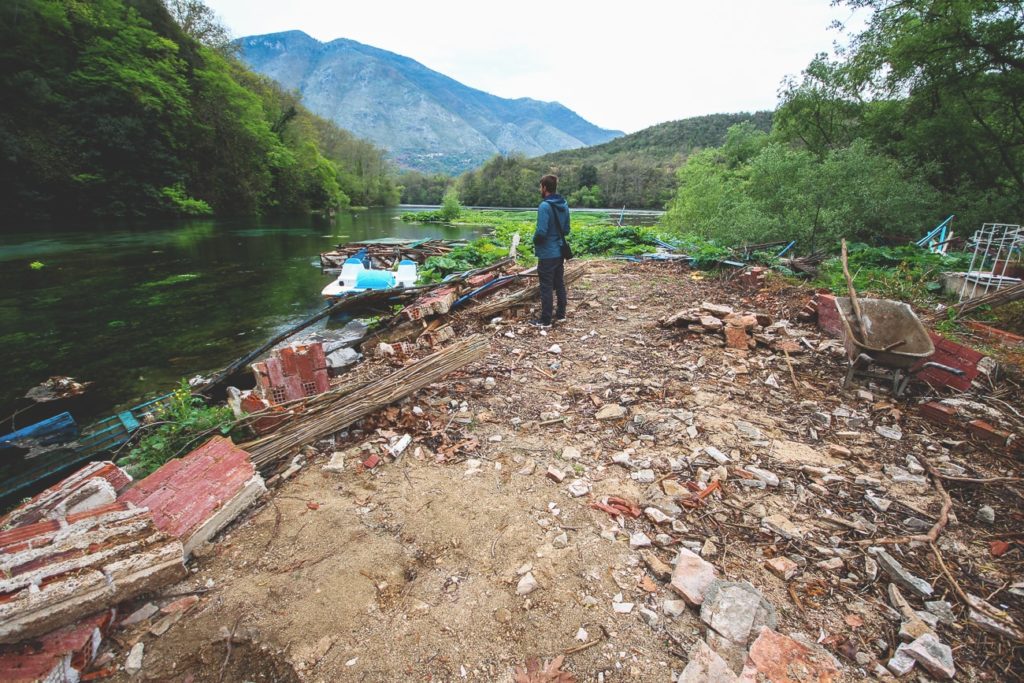
The country has so many beautiful corners, it’s such a shame that so much is buried in garbage. It’s imperative that Albania invests even more in environmental protection and infrastructure in the future. There are already several garbage dumps in the country, but it’s still not enough. However, the population is slowly getting fed up, and environmentalists are sounding the alarm.
A rethink is taking place, and one can only hope that politicians will finally take responsibility. You should be aware that Albania is a country full of contrasts, and you have to deal with such problems. If trash and dirt put you off, Albania is not the right country for you.
Conclusion: Albania
Albania is a great country. The people are warm, open, and hospitable. We had a really good time, never felt uncomfortable, and experienced wonderful moments. Traveling through the country was much easier than we expected. The roads are in good condition, costs are low, and the highlights are truly exciting.
For us, Albania is the perfect country for exploration, adventure, and a more cost-effective vacation. You can have a damn good time here in the off-season (May, June, September, and October). Probably also in peak season, but then with lots of tour buses, beachgoers, and holidaymakers.
Our Albania Podcast
Click on the button below to load the content from www.podbean.com.
Load content